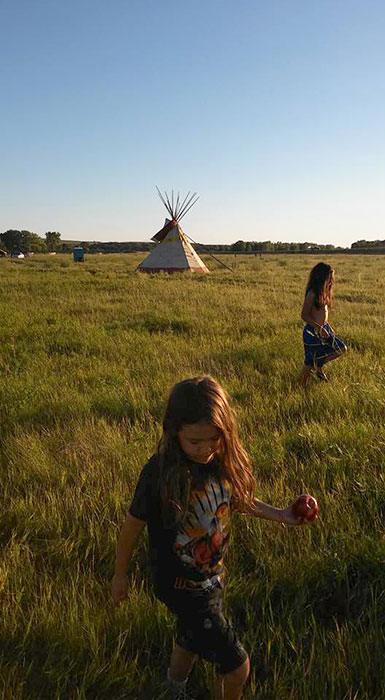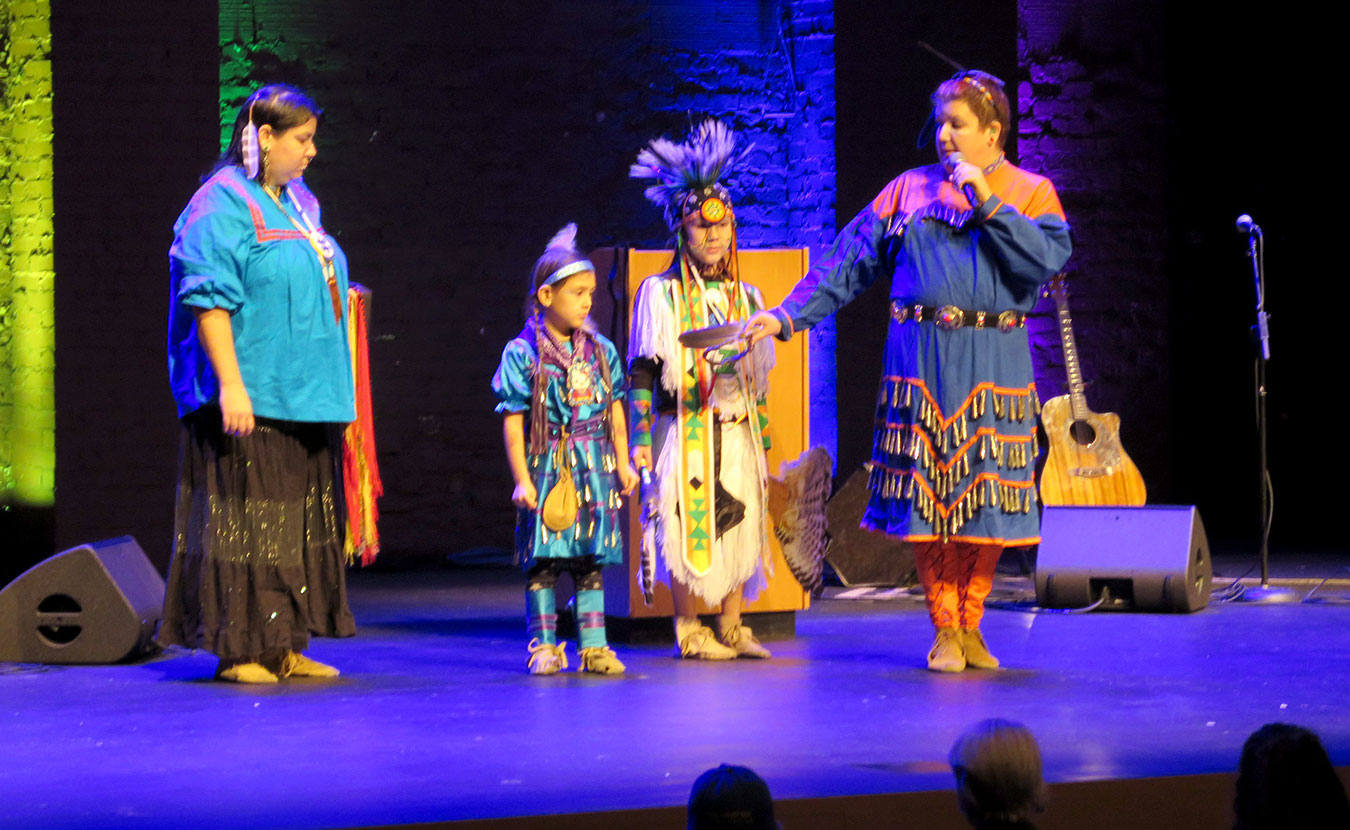As the presidential inauguration loomed closer and closer, a group of folks in Bloomington channeled their energy into Inaugurate the Revolution as an act of resistance to the incoming administration. Event organizers curated panels for the one-day conference in order to unite the community in a day of activism and engagement. While options included everything from movie screenings and art workshops to hearing from marginalized communities and learning more about a wide variety of societal problems, we’ve put together four stories showing the many issues people in our town are working on — and what you can do to help out. This is our second story in the series, on indigenous activism by Laura Martinez. Our first story was about the importance of media literacy by Elijah Pouges. The next story, by Tomi and Jim Allison, involves the issues (and solutions) regarding democratic reforms.
“Mni Wiconi.” Water is life.
Protestors of the Dakota Access Pipeline (DAPL) in North Dakota have rallied at Standing Rock and in cities across the United States to prevent the pipeline from going through unceded land, including a portion of the Missouri River and Lake Oahe, that was part of the 1868 Treaty of Fort Laramie. “Mni Wiconi” means “water is life” in the Dakota language, and The Water Protectors, as the protestors are known, use the simple but powerful message so that people will understand the purpose of the Standing Rock protests: No life on this planet can exist without water. We can survive without oil by investing in clean, renewable energy, but we cannot sustain life without clean water.
Beginning this past summer, Native and non-Native people from all over the country have been streaming into Standing Rock by the thousands. Many Native nations are banding together for the first time — some of whom had historically been enemies — because this pipeline has the potential to poison the water supply for not only the entire Standing Rock nation but also for the millions of people who get their drinking water directly or indirectly from the Missouri River. Equally important, the pipeline would irreparably damage sacred burial sites belonging to the Standing Rock people.

Martinez’s sister, Kelly Tudor, took this photo is of her children, Ohanna (front) and Aslan Tudor, at Standing Rock in August 2016. | Photo by Kelly Tudor
Many Native people believe in the power of their traditional spiritual practices and prayer. The importance of peaceful and prayerful occupation has been stressed to everyone involved in the protest, meaning the Water Protectors have remained peaceful throughout their entire encampment at Standing Rock. In return, the Water Protectors have been met with attack dogs, the National Guard, mass arrests, and inhumane treatment in the county jail, as well as being shot at with rubber bullets. Protector Sophia Wilansky, who had gone to Standing Rock from New York, nearly lost her arm after she was directly hit by one of the many percussion grenades thrown by militarized law enforcement.
***
Indigenous activism has been a part of my life for as long as I can remember. I am an enrolled citizen of the Lipan Apache Tribe of Texas and a proud third-generation member of the American Indian Movement. I was born in the mid-1980s, in a time when Native Americans were not making national headlines. Just prior to that, though, the 1970s saw the rise of the American Indian Movement, and their standoff at Wounded Knee was splashed in newspapers and on televisions across the country. Marlon Brando even refused his Oscar for The Godfather in protest of the treatment of Native Americans by the federal government and in protest of the stereotypical portrayal of Native Americans in film.
Native nations once again entered the American consciousness in the late 1980s and early 1990s with the Indian Gaming Regulatory Act. While arguing against Native casinos in 1993, Donald Trump famously said, “They don’t look like Indians to me.” To Trump, Native nations’ casinos were competition to his own casinos, specifically those in Atlantic City, and he did everything in his power to try to stop Native nations from being allowed to run them on their reservations. Trump has had a long and vocal history of hatred for Native nations — with nations being the part where he is lacking comprehension of meaning.
Native American nations are sovereign domestic nations, meaning Native American nations have the right to self-govern, define citizenship criteria, manage tribal lands, and regulate domestic business. According to the 1831 Supreme Court case, Cherokee Nation v. Georgia, Native American nations are defined as “domestic dependent nations,” which refers to the existence of sovereign self-governing nations within the United States — citizens of Native nations are considered citizens of both the United States and the nation they belong to. Since then, the federal government has violated nearly every treaty with Native nations, by taking over land that was to remain with a particular nation, damming rivers, and blocking Native hunting and fishing rights. Therefore, almost 25 years after those comments from Trump, it is understandable that Native Americans are resistant to and afraid of what the Trump administration will mean for them. The Trump administration is proving to be demonstrably bad news for Indian Country, as Trump advisors have already proposed privatizing oil-rich reservations, which would be terribly destructive to the environment as well as to Native sovereignty.
In 2016, Native Americans entered national and international headlines as the Standing Rock protest gained notoriety, but the Standing Rock Sioux Tribe has been fighting against the Dakota Access Pipeline (DAPL) since 2014, when it was originally proposed to go near Bismarck, North Dakota. Bismarck’s residents feared contamination of their water supply, and the plan for the pipeline was rerouted to go through land that was a part of the 1868 Treaty of Fort Laramie. This treaty was originally violated in 1889 when the federal government broke up the Sioux reservations and took control of that land.
Energy Transfer Partners (ETP), the company building the DAPL and other pipelines around the country, claim that the Standing Rock nation did not express their opposition to the pipeline, despite the fact that they met with ETP to do just that in 2014. Prior to that meeting, in 2012, the Standing Rock Sioux Tribe passed a resolution that declared they would approve neither a pipeline nor fracking on their land.
After months of protest, President Barack Obama’s administration issued an eleventh-hour denial of the easement for the pipeline to cross the Missouri River and Lake Oahe. However, in January, the Trump administration signed an executive memo that expressed its desire to move forward with not only the DAPL but also the controversial and previously denied Keystone Access Pipeline. Trump — not surprisingly — has been and may still be a a shareholder in ETP (a Trump spokesman claims Trump sold his shares but has offered no proof, according to The Atlantic and other news outlets). If so, Trump stands to profit from the construction of this pipeline, making it a clear conflict of interest.
Indigenous and non-indigenous groups have also been working together to fight other environmental issues, such as the Trans Pecos Pipeline, which is supposed to be laid through Lipan Apache and ranching land in the Texas Big Bend country, and the Sabal Trail Pipeline, which is proposed in Florida. The San Carlos Apache have been fighting to save their holy land, Oak Flat, since 2015, when it was sold to an Australian mining company in a last-minute addition to the National Defense Authorization Act. The controversial sale would allow the company to mine for copper on the ancient site, which is dotted with petroglyphs and plays a key role in the Apache creation myth.
So how can you help?
The first thing you can do is remove your funds from the big banks that have a stake in this and other pipelines — including Wells Fargo, Chase, Citibank, Morgan Stanley, PNC Bank, Citizens Bank, US Bank, and more — and let them know why you are closing your account. In this capitalist economy, money speaks the loudest. Take your cash and invest it elsewhere.
Next, make sure that when you share information about the ongoing protest at Standing Rock (or any other protests happening around the country), you are sharing information from accurate and verified sources. Indian Country Today, Last Real Indians, and well-known protestors and activists such as Dallas Goldtooth have been good at quelling the rumor mill, but misinformation can still spread. I’ve seen posts written by people claiming to be at protests, yet they’re sharing information that opposes what my family and friends who were there have witnessed. Follow the Oceti Sakowin and Sacred Stone camps directly, as they will be sharing the most accurate and up-to-date information.
Be aware that the Standing Rock Sioux Tribe has requested that people do not come to join the protests at present, and the Oceti Sakowin camp has been evicted — the reason cited for eviction being imminent spring flooding. Though they left peacefully, friends of mine who were present reported being “escorted” out at gunpoint. You can follow them directly on social media to see what they need to continue the fight until they are ready for people to join them again. The Sacred Stone camp is still active.
Together, Native Americans and allies can defeat the pipelines that threaten our water and land, but we must work together and respect the rights and sovereignty of the indigenous people of this land to achieve these goals. Lawrence O’Donnell, an MSNBC journalist, recently referred to Native Americans as the “original environmentalists.” Where Europeans and people of European ancestry often believe that the earth is here for their use, Native Americans more often believe that we are here to exist with the earth, not to dominate it. This belief factors into our traditional spiritual practices as well as into our daily activities.
The best way to be an ally to indigenous activists and indigenous people is to listen. Listen to our concerns, and act accordingly and respectfully. We can’t save the world alone, and we need our voices to be heard.



